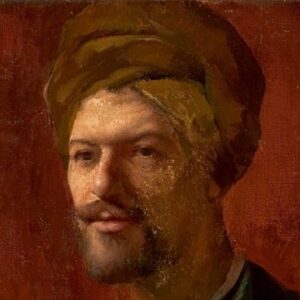Rodolfo Amoedo, a well-known Brazilian painter and decorator, was one of the primary figures behind the National School of Fine Arts’ resuscitation of teaching and academic aesthetics (Enba). Though Amoedo’s style was staunchly conventional, he made a significant contribution to the advancement of academic painting to new aesthetic trends, signaling the end of the Neoclassical and Romantic styles that had dominated Brazil until then. He was sometimes referred to as an ambivalent artist because he was both innovative and fiercely protective of ancient values. During his lifetime, he was affected greatly by the lectures of Alexandre Cabanel (1823 – 1889), Paul Baudry (1828 – 1886), and Pierre Puvis de Chavannes (1824 – 1898), all of whom encouraged him to employ subtle colors to create thorough and objective drawings. Rodolfo Amoedo painted on the theme of classic academics in an attempt to remove the ideal trappings.
Childhood and Early Years of Rodolfo Amoedo
Rodolfo Amoedo’s roots are hazy; some claim he was born in Salvador, while others claim he was born on the land of Rio de Janeiro. There is enough evidence, however, to suggest that the painter spent a significant portion of his infancy in Salvador. Amoedo’s parents were performers, according to art historian Quirino Campofiorito’s archives, and he had a spartan upbringing, as much of his early life was marred by financial difficulties.
He came to Rio de Janeiro when he was 11 years old to study at Pedro II College, but had to abandon his studies due to a lack of cash. At the age of 16, he joined in an Arts and Crafts School and was mentored by Antonio de Souza Lobo, Victor Meirelles, Zeferino da Costa, Agostinho da Motta, and Chaves Pinheiro.
Rodolfo Amoedo began his creative career in 1873 under the supervision of Victor Meirelles. In 1878, he earned Aiba’s foreign travel prize for his painting “The Sacrifice of Abel” at the Brazilian Academy, which was his first big break. He moved to Paris in 1879 to study art and painting at the Ecole National des Beaux-Arts. He also had the wonderful fortune of being Alexander Cabanel’s protégé and having the opportunity to work under Paul-Jacques-Aime Baudry. There, he learned how to create careful artworks by using subtle colors. ‘Marabá’ (1882) and ‘The Last Tamoyo’ are two of his notable works on indigenous themes (1883).
His artistic brilliance may be seen in works such as ‘Sulking Woman’ (1882) and ‘Woman’s Back’ (1881). ‘The Departure of Jacob’ (1884) and ‘Jesus in Capernaum’ (1885) are two biblical paintings he painted (1885). During the fall of the Brazilian Empire, Rodolfo Amoedo renamed the School of Fine Arts Escola Nacional de Belas Artes. In 1887, he started as a painting professor at Aiba and later became the director of the Brazilian Academy.
Legacy And Death
Rodolfo Amoedo died in Rio de Janeiro on May 31, 1941, and was forgotten. As a result, his widow was thrown into destitution. As a result, his friends assisted the widow in paying for the funerals. However, the fact that his paintings still decorate the walls of the National Museum Museu Nacional de Belas Artes in Rio de Janeiro attests to his grandeur.
The Last Tamoyo (1882), Abel’s Offering (1878), Maraba (1882) (Ultimo Tamoio), Sulking Woman, 1883 (Amuada), 1882 Female Study (Estudo de Mulher), 1884 Jacob’s Departure (A Partida de Jaco), 1884 Jesus In Capernaum (Jesus emKafarnaum), 1885 Awards And Accomplishments
Rodolfo Amoedo was awarded first prize in the Brazilian Academy in 1878. For ‘Sacrificio de Abel’ (The Sacrifice of Abel), he received Aiba’s foreign travel prize, which allowed him to travel to Paris from 1879 to 1887.
Estimated Net Worth
The estimated net worth of Rodolfo Amoedo is unknown.


